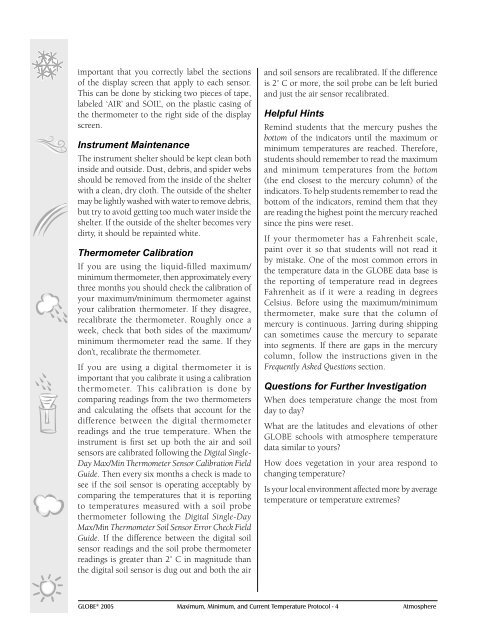Maximum, Minimum, and Current Temperature Protocol - GLOBE
Maximum, Minimum, and Current Temperature Protocol - GLOBE
Maximum, Minimum, and Current Temperature Protocol - GLOBE
Create successful ePaper yourself
Turn your PDF publications into a flip-book with our unique Google optimized e-Paper software.
important that you correctly label the sections<br />
of the display screen that apply to each sensor.<br />
This can be done by sticking two pieces of tape,<br />
labeled ‘AIR’ <strong>and</strong> SOIL’, on the plastic casing of<br />
the thermometer to the right side of the display<br />
screen.<br />
Instrument Maintenance<br />
The instrument shelter should be kept clean both<br />
inside <strong>and</strong> outside. Dust, debris, <strong>and</strong> spider webs<br />
should be removed from the inside of the shelter<br />
with a clean, dry cloth. The outside of the shelter<br />
may be lightly washed with water to remove debris,<br />
but try to avoid getting too much water inside the<br />
shelter. If the outside of the shelter becomes very<br />
dirty, it should be repainted white.<br />
Thermometer Calibration<br />
If you are using the liquid-filled maximum/<br />
minimum thermometer, then approximately every<br />
three months you should check the calibration of<br />
your maximum/minimum thermometer against<br />
your calibration thermometer. If they disagree,<br />
recalibrate the thermometer. Roughly once a<br />
week, check that both sides of the maximum/<br />
minimum thermometer read the same. If they<br />
don’t, recalibrate the thermometer.<br />
If you are using a digital thermometer it is<br />
important that you calibrate it using a calibration<br />
thermometer. This calibration is done by<br />
comparing readings from the two thermometers<br />
<strong>and</strong> calculating the offsets that account for the<br />
difference between the digital thermometer<br />
readings <strong>and</strong> the true temperature. When the<br />
instrument is first set up both the air <strong>and</strong> soil<br />
sensors are calibrated following the Digital Single-<br />
Day Max/Min Thermometer Sensor Calibration Field<br />
Guide. Then every six months a check is made to<br />
see if the soil sensor is operating acceptably by<br />
comparing the temperatures that it is reporting<br />
to temperatures measured with a soil probe<br />
thermometer following the Digital Single-Day<br />
Max/Min Thermometer Soil Sensor Error Check Field<br />
Guide. If the difference between the digital soil<br />
sensor readings <strong>and</strong> the soil probe thermometer<br />
readings is greater than 2˚ C in magnitude than<br />
the digital soil sensor is dug out <strong>and</strong> both the air<br />
<strong>and</strong> soil sensors are recalibrated. If the difference<br />
is 2˚ C or more, the soil probe can be left buried<br />
<strong>and</strong> just the air sensor recalibrated.<br />
Helpful Hints<br />
Remind students that the mercury pushes the<br />
bottom of the indicators until the maximum or<br />
minimum temperatures are reached. Therefore,<br />
students should remember to read the maximum<br />
<strong>and</strong> minimum temperatures from the bottom<br />
(the end closest to the mercury column) of the<br />
indicators. To help students remember to read the<br />
bottom of the indicators, remind them that they<br />
are reading the highest point the mercury reached<br />
since the pins were reset.<br />
If your thermometer has a Fahrenheit scale,<br />
paint over it so that students will not read it<br />
by mistake. One of the most common errors in<br />
the temperature data in the <strong>GLOBE</strong> data base is<br />
the reporting of temperature read in degrees<br />
Fahrenheit as if it were a reading in degrees<br />
Celsius. Before using the maximum/minimum<br />
thermometer, make sure that the column of<br />
mercury is continuous. Jarring during shipping<br />
can sometimes cause the mercury to separate<br />
into segments. If there are gaps in the mercury<br />
column, follow the instructions given in the<br />
Frequently Asked Questions section.<br />
Questions for Further Investigation<br />
When does temperature change the most from<br />
day to day?<br />
What are the latitudes <strong>and</strong> elevations of other<br />
<strong>GLOBE</strong> schools with atmosphere temperature<br />
data similar to yours?<br />
How does vegetation in your area respond to<br />
changing temperature?<br />
Is your local environment affected more by average<br />
temperature or temperature extremes?<br />
<strong>GLOBE</strong> ® 2005 <strong>Maximum</strong>, <strong>Minimum</strong>, <strong>and</strong> <strong>Current</strong> <strong>Temperature</strong> <strong>Protocol</strong> - 4 Atmosphere
















